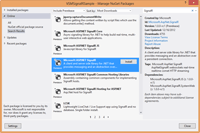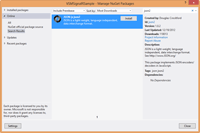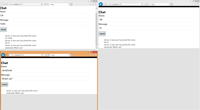Building Web Apps with SignalR, Part 1
Building Web Apps with SignalR, Part 1
In the first installment of app-building with SignalR, learn how to build a real-time chat application.
- By Eric Vogel
- 01/22/2013
Are you sick of that dreaded page refresh? Want to turn your Web application up to 11? If you've answered yes to either question, SignalR is for you. With SignalR, you can provide content to your users in real-time, all from ASP.NET. Most importantly, it's compatible with browsers ranging all the way back to IE6! SignalR uses WebSockets on supported browsers and will fall back to server-side events, Forever Frame, or AJAX long polling if needed. This means you can use a single library and not have to worry about that minutia.
There are two approaches you can use with SignalR to achieve real-time communications: a persistent connection or a hub. The persistent connection API allows you to keep open a persistent connection between the client and server to send and receive data. The hub API is an abstraction above the persistent connection API, and is suitable for remote procedure calls (RPC).
This article will focus on the persistent connection API. I believe the best way to learn a new technology is to build something useful with it, so we'll create a chat client using SignalR. To get started, create a new C# ASP.NET MVC 4 project from Visual Studio 2012, then select the Web API option for your project type. Next, install the Microsft SignalR pre-release NuGet package through the NuGet Package Manager (Figure 1).
 [Click on image for larger view.] |
| Figure 1. Installing the SignalR pre-release NuGet package. |
In order to support IE 6 and 7, install the JSON-js-json2 NuGet Package as well, as shown inFigure 2.
 [Click on image for larger view.] |
| Figure 2. JSON2 NuGet package installation. |
Without further ado, let's get started on this app. First create a new folder in the project named Chat. Then create a new class named ChatConnection within the Chat directory that inherits from PersistentConnection. You'll need to add a using statement for the Microsoft.AspNet.SignalR namespace.
Now open up the RouteConfig class under the App_Start folder in the project. Add a using statement for the Microsoft.Asp.Net.Signal namespace to the RouteConfig class:
using Microsoft.AspNet.SignalR;
Next, register the ChatConnection class to the "chat" route in the RegisterRoutes method in the RouteConfig class:
RouteTable.Routes.MapConnection<ChatConnection>("chat","chat/{*operation}");
Your completed RouteConfig class should resemble Listing 1.
Now to create the ChatData data structure that will be used to interchange data between the client and the server. Create a new class named ChatData with Message and Name string data type properties:
namespace VSMSignalRSample.Chat
{
public class ChatData
{
public string Name { get; set; }
public string Message { get; set; } public ChatData()
{
} public ChatData(string name, string message)
{
Name = name;
Message = message;
}
}
}
Now it's time to finish implementing the ChatConnection class, which will receive and broadcast chat messages. Add using statements for the System.Threading.Tasks and Newtonsoft.Json namespaces. Next, add a private Dictionary<string, string> to store the clients that connect to the chat room:
private Dictionary<string, string> _clients = new Dictionary<string, string>();
The PersistentConnection base class includes functionality for dealing asynchronously with a few critical server-side events such as a new connection, disconnection, reconnection and data retrieval. Let's implement the OnConnectedAsync event handler first. When a new user first joins the room, they're added to the _clients Dictionary object, which will be used to map the user's chosen chat name with their connectionId. Then a broadcast message is sent to all users, letting them know a new user has joined the chat room:
protected override Task OnConnectedAsync(IRequest request, string connectionId)
{
_clients.Add(connectionId, string.Empty);
ChatData chatData = new ChatData("Server", "A new user has joined the room.");
return Connection.Broadcast(chatData);
}
Now it's time to tackle data retrieval from a connected client through the OnReceivedAsync event handler. First, the JSON data object from the client is desterilized into a ChatData object through JSON.NET. Then the user's name is stored in the _clients dictionary. Finally, the user's ChatData is broadcast to all users:
protected override Task OnReceivedAsync(IRequest request, string connectionId, string data)
{
ChatData chatData = JsonConvert.DeserializeObject<ChatData>(data);
_clients[connectionId] = chatData.Name;
return Connection.Broadcast(chatData);
}
The last event to handle is client disconnection, via the OnDisconnectedAsync method. When a user disconnects, he or she is removed from the _clients dictionary. Then a message is broadcast to all users, letting them know a user has left the room:
protected override Task OnDisconnectAsync(IRequest request, string connectionId)
{
string name = _clients[connectionId];
ChatData chatData = new ChatData("Server", string.Format("{0} has left the room.", name));
_clients.Remove(connectionId);
return Connection.Broadcast(chatData);
}
Now it's time to create the client-side JavaScript that will communicate with the persistent chat connection to display incoming chat messages and chat room events to the user. Create a new JavaScript file named ChatR.js within the Scripts folder. The first step is to retrieve the server chat connection object through the SignalR JavaScript plug-in:
var myConnection = $.connection("/chat");
Next, the received event is set up to display a received chat message as a new list item element in the messages unordered list DOM element:
myConnection.received(function (data) {
$("#messages").append("<li>" + data.Name + ': ' + data.Message + "</li>");
});
After that, the error handler for the connection is set up to display a console warning. This is mainly to ease debugging of the chat connection:
myConnection.error(function (error) {
console.warn(error);
});
Lastly, a connection is initiated to the chat server and a continuation is set up to handle the message send button-click event. Within the button-click event handler, the user's name and message are retrieved from the name and message text boxes, respectively. Then the user's name and message are sent to the chat server as a JSON object, as shown in Listing 2.
Now it's time to set up the UI for the Web application. Add a new MVC View class to the Home directory, named ChatR, that binds to the Chat.ChatData model. In the bottom of the view add a script reference to the ~/Sciprts/ChatR.js script created earlier:
@{
ViewBag.Title = "Chat";
}
<h2>Chat</h2>
@using (Html.BeginForm()) {
@Html.EditorForModel();
<input id="send" value="send" type="button" />
<ul id="messages" style="list-style:none;"></ul>
}
@section Scripts { <script src="~/Scripts/ChatR.js"></script> }
Now, add a controller action method named ChatR to the HomeController that returns a new view bound to an empty Chat.ChatData object:
public ActionResult ChatR()
{
var vm = new Chat.ChatData();
return View(vm);
}
That's it: sit back, relax and invite a few friends to try out your new chat app, shown in Figure 3.
 [Click on image for larger view.] |
| Figure 3. The completed real-time chat application. |
As you can, see SignalR is quite easy to work with and the PersistentConnection API is very flexible. With SignalR, you can tackle a plethora of real-time Web app use cases from business to gaming. Stay tuned for the next installment, which covers how to use the SignalR Hub API to create a dynamic form.
About the Author
Eric Vogel is a Sr. Software Developer at Kunz, Leigh, & Associates in Okemos, MI. He is the president of the Greater Lansing User Group for .NET. Eric enjoys learning about software architecture and craftsmanship, and is always looking for ways to create more robust and testable applications. Contact him at vogelvision@gmail.com.
Building Web Apps with SignalR, Part 1的更多相关文章
- Building Modern Web Apps-构建现代的 Web 应用程序
Building Modern Web Apps-构建现代的 Web 应用程序 视频长度:1 小时左右 视频作者:Scott Hunter 和 Scott Hanselman 视频背景:Visual ...
- Isomorphic JavaScript: The Future of Web Apps
Isomorphic JavaScript: The Future of Web Apps At Airbnb, we’ve learned a lot over the past few years ...
- Why mobile web apps are slow
http://sealedabstract.com/rants/why-mobile-web-apps-are-slow/ I’ve had an unusual number of interest ...
- Isomorphic JavaScript: The Future of Web Apps(译)
Isomorp ...
- appium(4)-Automating mobile web apps
Automating mobile web apps If you’re interested in automating your web app in Mobile Safari on iOS o ...
- 在线文档预览方案-office web apps续篇
上一篇在线文档预览方案-office web apps发布后收到很多网友的留言提问,所以准备再写一篇,一来介绍一下域控服务器安装,总结一下大家问的多的问题,二来宣传预览服务安装与技术支持的事情. 阅读 ...
- 安装部署完office web apps 后,无法浏览Word
安装部署完office web apps 后,在sharepoint 2010浏览器中浏览Word提示:“由于出现意外错误,Word Web App 无法打开此 文档 进行查看. 要查看此 文档,请在 ...
- 在线文档预览方案-office web apps
最近在做项目时,要在手机端实现在线文档预览的功能.于是百度了一下实现方案,大致是将文档转换成pdf,然后在通过插件实现预览.这些方案没有具体实现代码,也没有在线预览的地址,再加上项目时间紧迫.只能考虑 ...
- 免费电子书:Azure Web Apps开发者入门
(此文章同时发表在本人微信公众号"dotNET每日精华文章",欢迎右边二维码来关注.) 题记:之前介绍过微软正在逐步出版一个名为Azure Essential的入门系列教程,最近刚 ...
随机推荐
- C++编写ATM(1)
// ATM的初始.cpp : 定义控制台应用程序的入口点. // /************************************************* 运行环境: VS2008 作者 ...
- Java集合中那些类是线程安全的
线程安全类 在集合框架中,有些类是线程安全的,这些都是jdk1.1中的出现的.在jdk1.2之后,就出现许许多多非线程安全的类. 下面是这些线程安全的同步的类: vector:就比arraylist多 ...
- UINavigationController 导航控制器 ,根据文档写的一些东西
今天讲了导航控制器UINavigationController 和标签栏视图控制器UITabBarController 先来说一说导航视图控制器 UINavigationController 导航控 ...
- Oralce新建数据库、新建远程登录用户全过程
Oracle安装完后,其中有一个缺省的数据库,除了这个缺省的数据库外,我们还可以创建自己的数据库. 对于初学者来说,为了避免麻烦,可以用'Database Configuration Assi ...
- 【深入了解cocos2d-x 3.x】定时器(scheduler)的使用和原理探究(3)
上篇文章分析到了定时器的定义.这篇的重点就是定时器是怎样执行起来的. 1.从main中寻找定时器的回调 讲定时器的执行,就不得不触及到cocos2dx的main函数了,由于定时器是主线程上执行的.并非 ...
- 高仿“点触验证码”做的一个静态Html例子
先上源码: <html> <head> <title>TouClick - Designed By MrChu</title> <meta htt ...
- MediaPlayer 音频播放 示例
状态机.流程图.生命周期 对播放音频/视频文件和流的控制是通过一个状态机来管理的.下图显示一个MediaPlayer对象被支持的播放控制操作驱动的生命周期和状态. 椭圆代表MediaPlayer对象可 ...
- 10-利用com组件读取office
using System; using System.Collections.Generic; using System.Linq; using System.Text; using System.I ...
- javascript小数四舍五入
javascript小数四舍五入 1. function get(){ var s = 22.127456 + ""; var str = s.substring(0, ...
- jQuery幻灯插件:Nivo Slider
使用步骤 1.引入css文件 default.css 设置展示插件所需的样式,像控制导航键,导航按钮样式,当然你可以自己写个样式 nivo-slider控制图片样式,插件所需的CSS文件 <li ...
